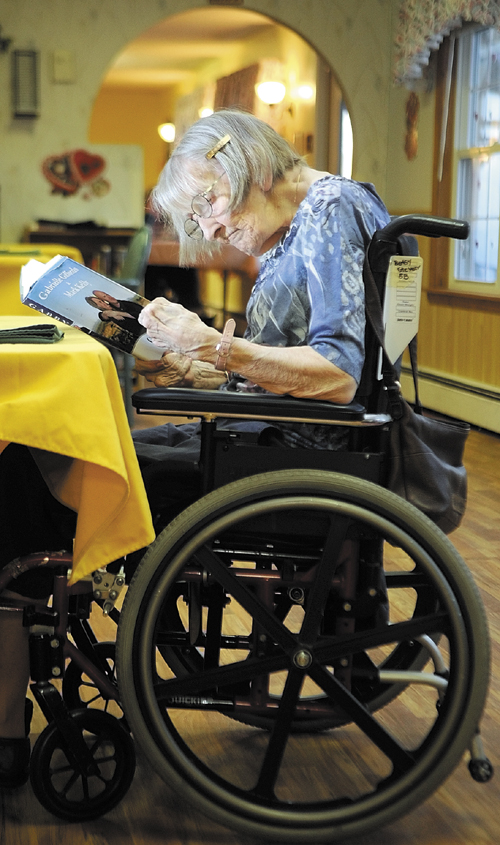The Oak Grove Center nursing home in Waterville swirled with activity last week, with a beano game in one room, two women chatting over coffee in another, and an ambulance crew wheeling in a new resident on a gurney.
A nurse typed on a wall-mounted computer in the hall, and administrator Sara Sylvester took a turn answering the phone in the front lobby so one of her employees could go to lunch.
The staff of 130 full- and part-time workers often do double duty, but they don’t get paid overtime.
The facility provides care 24 hours a day, seven days a week for 90 people. It is one of 107 nursing homes statewide that are continuing to deal with chronic underfunding from the state. Over the past five years, the nursing homes have been underfunded by $122 million in state and federal funds, and places such as Oak Grove run an average of $340,000 short every year, according to the Maine Health Care Association, a trade group that represents most nursing homes in Maine.
The payments fall short because they are based on a 2005 formula, so even as utility and other costs have gone up, the payments have not.
“I’ve had to cut back on the night shift,” Sylvester said. “I don’t have an afternoon-evening receptionist. We don’t do any overtime.”
In Winthrop, at Heritage Rehabilitation & Nursing Center, MaineCare funding fell short of expenses by $99,250 in 2011, administrator Matthew Lessard said.
He, too, struggles with staffing, particularly because he can’t pay competitive wages.
“We still push to provide the best quality care, but we can’t keep up with wages offered in other industries,” he said. “We have a set rate based on 2005 data to pay people in 2013.”
The center employs 86 to 100 people, either full-time, part-time or on a per-day basis. There are 28 nursing home beds and 24 people who live in the residential care unit.
Another factor to consider is that Maine has stringent standards when it comes to allowing people to live in nursing homes, which means those who live in the facilities suffer from multiple health problems, Lessard said. Also, Maine has a large population of older residents, putting more strain on the system.
“It’s almost like they could get hidden,” Lessard said. “It’s our job as advocates to ensure that doesn’t continue to happen.”
To that end, the health association recently launched a renewed effort to get the funding necessary to keep the homes open and safe. In the coming weeks and months, the association will push for a bill before the Legislature that seeks to increase MaineCare rates paid to nursing homes, give more money to facilities where more than 70 percent of residents rely on MaineCare, and set up a system that rewards nursing homes based on performance.
Those changes are estimated to cost $6.5 million over two years, which would come from the state budget.
Richard Erb, the association’s president, said he doesn’t think it’s unrealistic to ask for $6.5 million out of a $6.2 billion state budget.
He said $6.5 million “is a lot of money for us, but within the entire state budget, I don’t think that’s unachievable,” he said.
Nursing homes will have to compete for funds against other social service programs in the budget, including a prescription drug program for the elderly and disabled, which is proposed for elimination; and substance-abuse prevention and community mental health services, both of which are expecting funding cuts. Also, municipalities have vowed to fight the proposed loss of all of their state funding for the next two years.
In recent weeks, Gov. Paul LePage has touted his intention to pay back hospitals $186 million owed in Medicaid payments. Nursing homes aren’t seeking to recoup any debt, but they need the state to update its formula so it comes closer to keeping pace with expenses moving forward, Erb said.
A lack of MaineCare funds, which is the state’s version of Medicaid, hits nursing homes particularly hard because 73 percent of their operating funds come from MaineCare.
And while the facilities traditionally have passed some of those expenses on to private-pay residents — the average private-pay rate is 40 percent higher than MaineCare — that pool of money has dried up in recent years, Sylvester said.
“Private pay doesn’t help anymore,” she said. “It doesn’t make up the difference.”
At Oak Grove, 51 of the 90 residents are MaineCare-eligible. Even those who saved money to pay for their long-term care find that it doesn’t take long to spend down the money and end up on MaineCare, she said.
Statewide, nursing homes employ nearly 10,000 people full-time, according to the health care association. Erb said many of the nursing homes are in fragile financial condition, and he pointed to the closure last year of a Washington County nursing home as the first sign that many are in trouble.
The Atlantic Rehabilitation and Nursing Center in Calais closed in June, citing financial problems. Erb said 90 percent of the residents were on MaineCare, a percentage higher than normal, but not unusual, for a rural facility. The parent company of the Calais facility has said it intends to build a nursing home in Ellsworth, which is 93 miles from Calais.
Without increased state funding, Erb said more and more nursing homes are at risk. He’s also concerned about the possibility that Medicare — the federal health care program for those 65 and over — will be cut further at the federal level.
That will eat into the amount of money that now is paid to nursing homes that provide temporary rehabilitation services.
“Over the next two years, I would expect we would see closures, reducing access in rural areas; and then distance becomes an issue,” he said.
Susan Cover — 621-5643
scover@mainetoday.com
Send questions/comments to the editors.



